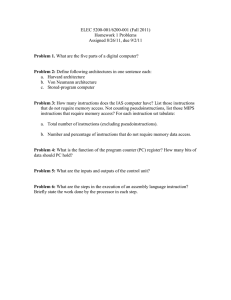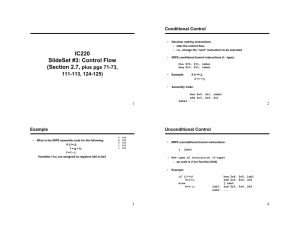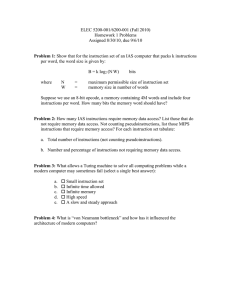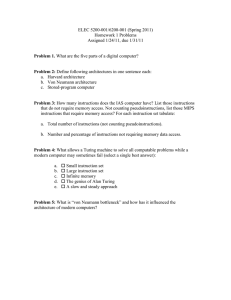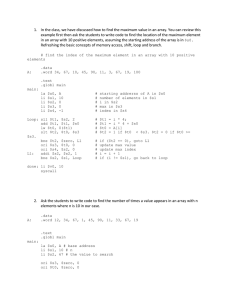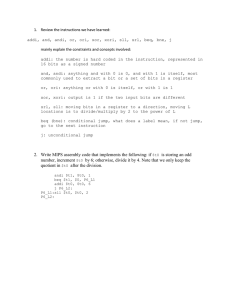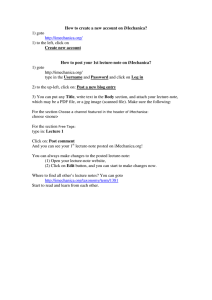Extended Assembler
advertisement
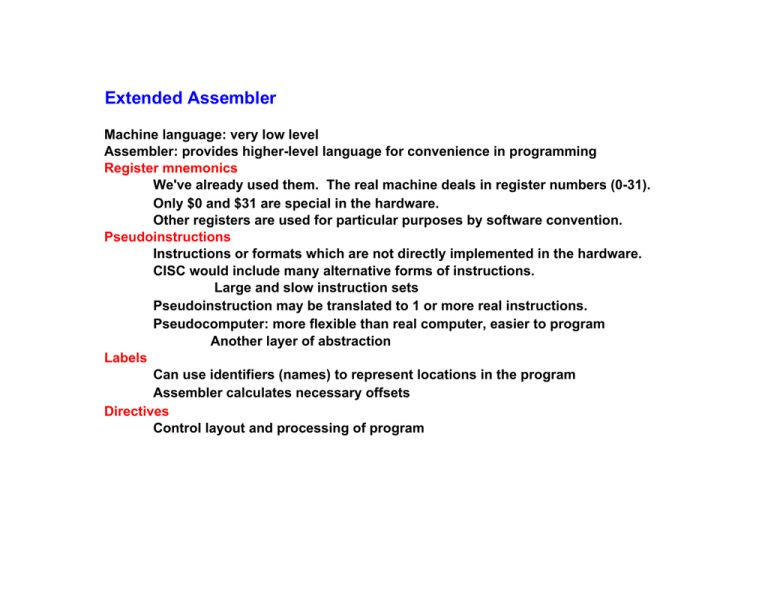
Extended Assembler Machine language: very low level Assembler: provides higher-level language for convenience in programming Register mnemonics We've already used them. The real machine deals in register numbers (0-31). Only $0 and $31 are special in the hardware. Other registers are used for particular purposes by software convention. Pseudoinstructions Instructions or formats which are not directly implemented in the hardware. CISC would include many alternative forms of instructions. Large and slow instruction sets Pseudoinstruction may be translated to 1 or more real instructions. Pseudocomputer: more flexible than real computer, easier to program Another layer of abstraction Labels Can use identifiers (names) to represent locations in the program Assembler calculates necessary offsets Directives Control layout and processing of program Pseudoinstructions: Data transfer (register) Instruction Real instructions Copy contents of register s to register t mov $rt, $rs addi $rt, $rs, 0 Semantics R[t] = R[s] Load immediate into register s li $rs, immed R[s] = immed The way this is translated depends on whether immed is 16 bits or 32 bits: li $rs, small ori $rs, $0, small R[s] = small li $rs, -small addiu $rs, $0, -small R[s] = -small li $rs, big lui $rs, upper(big) R[s] = big ori $rs, $rs, lower(big) small: 16-bit value big: 32-bit value Note: upper(big) and lower(big) are not real instruction syntax The assembler must figure out how to get the upper 16 bits of a 32-bit value: upper (big) = big31-16 lower (big) = big15-0 Load address into register s la $rs, addr lui $rs, upper(addr) ori $rs, $rs, lower(addr) R[s] = addr Pseudoinstructions: Data transfer (memory) Load a word into memory with a 32-bit offset (called big). Notice that this is normally not allowed, because only 16-bit offsets are permitted. Instruction Real instructions Semantics lw $rt, big($rs) lui $at, upper( big ) Addr <-- R[s] + big ori $at, $at, lower( big ) R[t] <-- M4[ Addr ] add $at, $rs, $at lw $rt, 0($at) Similar pseudo-instructions exist for sw, etc. Other size load, store: ld, sd doubleword ulh, ulw, ush, usw unaligned halfword, word Pseudoinstructions: Branch How do we compare values in 2 registers? Instructions for beq, bne, but not for general relational operators result slt $rd, $rs, $rt R[s] < R[t] 1 R[s] >= R[t] 0 Instruction Real instructions Semantics bge $rs, $rt, LABEL slt beq slt bne slt beq slt bne if (R[s] >= R[t]) goto LABEL if (R[s] > R[t]) goto LABEL if (R[s] <= R[t]) goto LABEL if (R[s] < R[t]) goto LABEL bgt $rs, $rt, LABEL ble $rs, $rt, LABEL blt $rs, $rt, LABEL $at, $at, $at, $at, $at, $at, $at, $at, $rs, $rt $zero, LABEL $rt, $rs $zero, LABEL $rt, $rs $zero, LABEL $rs, $rt $zero, LABEL Note that LABEL must be converted to an offset from PC What about immediate value? bge $rs, immed, LABEL Pseudoinstructions: Branch Comparison to 0 Instruction beqz $rs, LABEL Real instructions beq $rs,$zero,label bnez $rs, LABEL bne $rs,$zero,label Semantics if (R[s] == 0) goto LABEL if (R[s] != 0) goto LABEL Pseudoinstructions: Arithmetic Instruction Multiply mul $rd, $rs, $rt Multiply with overflow mulo $rd, $rs, $rt Real instructions Semantics multu $rs, $rt mflo $rd # R[d] = R[s] * R[t] mult $rs, $rt mflo $rd # check for overflow # R[d] = R[s] * R[t] Pseudoinstructions: Set Instruction Set if equal: seq $rd, $rs, $rt Real instructions andi $rd, $rd, 0 bne $rs, $rt, next ori $rd, $zero, 1 next: What's wrong with this? Better way: xor $rd, $rs, $rt sltiu $rd, $rd, 1 Set if not equal: sne $rd, $rs, $rt xor $rd, $rs, $rt sltu $rd, $0, $rd Set if greater than or equal: sge $rd, $rs, $rt slt $rd, $rs, $rt xori $rd, $rd, 1 Other combinations, including unsigned: sgeu, sgt, sgtu, sle, sleu Semantics # R[d] = (R[s] == R[t]) ? 1 : 0 # R[d] = ~(R[s] == R[t]) # R[d] = (R[d] < 1) # R[d] = (R[s] != R[t]) ? 1 : 0 # R[d] = ~(R[s] == R[t]) # R[d] = (R[d] > 0) # R[d] = (R[s] >= R[t]) ? 1 : 0 # R[d] = (R[s] < R[t]) ? 1 : 0 # R[d] = ~R[d] Pseudoinstructions: logical Instruction not $rd, $rs Better way: not $rd, $rs Why does this work? a 0 0 1 1 Real instructions addi $at, $0, -1 xor $rd, $rs, $at Semantics # R[1] = -1 # R[d] = R[s] ^ R[1] nor $rd, $rs, $0 # R[d] = ~R[s] b 0 1 0 1 a | b ~(a|b) ~(0|b) 0 1 1 1 0 0 1 0 1 0 ~b 1 0 Pseudoinstructions: summary Data transfer Branch Set Arithmetic Logical Register Constant Address Big offset Greater than or equal Greater than Less than or equal Less than Equal 0 Not equal 0 Equal Not equal Greater than or equal Greater than Less than or equal Multiply Multiply (overflow) Complement mov li la lw bge bgt ble blt beqz bnez seq sne sge sgt sle mul mulo not Extended Assembler ## Program to add two plus three .text .globl main main: ori ori addu $8,$0,0x2 $9,$0,0x3 $10,$8,$9 # put two's comp. two into register 8 # put two's comp. three into register 9 # add register 8 and 9, put result in 10 ## End of file Directives .text defines beginning of source code .globl identifies global label Label (symbolic address) main Defining data .data # defines arr: .word 2, 4, 6 # defines chr: .byte 65 # defines str: .asciiz "a string" # defines beginning of data area array of 3 words (int) 1 byte (char) a C-type character string This document was created with Win2PDF available at http://www.daneprairie.com. The unregistered version of Win2PDF is for evaluation or non-commercial use only.
